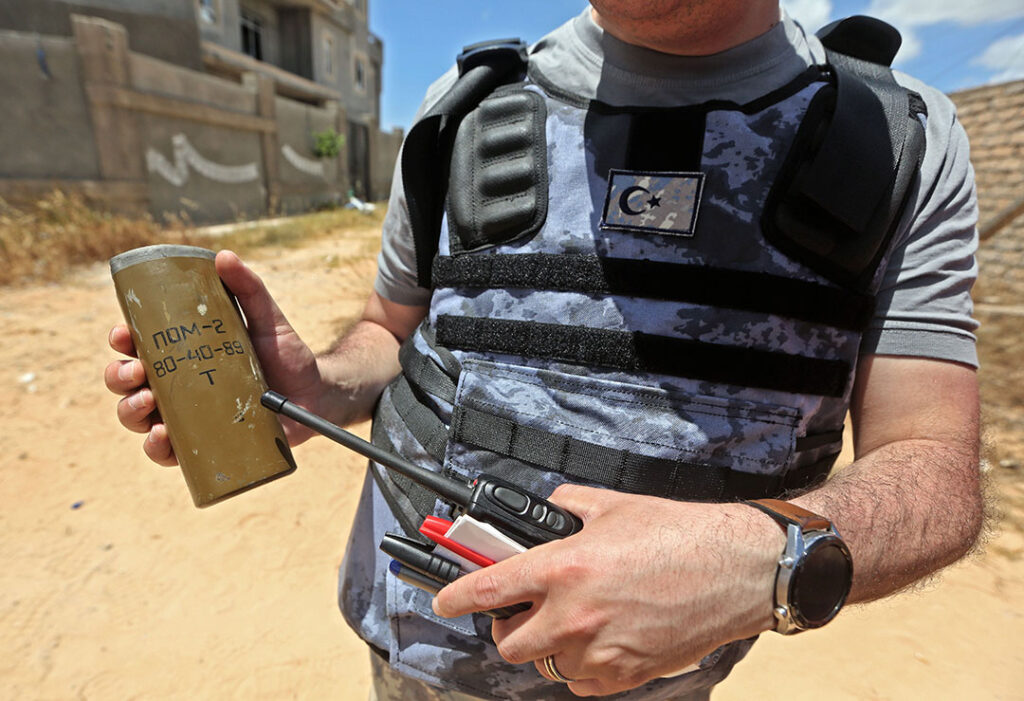ADF staff
In a retreat from the southern outskirts of Tripoli, militia forces loyal to commander Khalifa Haftar left behind a shadow of death in the form of land mines.
Advancing troops serving in Libya’s Government of National Accord (GNA) Army, the United Nations-recognized force, have discovered booby-trapped ordnance lying in wait for residents returning to their homes in the Ain Zara and Salah al-Din neighborhoods of Tripoli. Anti-personnel mines litter spaces where civilians might otherwise expect to feel safe.
“Residential homes and streets, children’s toys along with play areas were booby-trapped,” GNA Brig. Ahmed Bayou told Al-Jazeera recently as he stood amid the wreckage of a Tripoli neighborhood. “This proves that it is residents who are targeted by these land mines when they return to their homes. When a land mine is planted in a toy, who is the target? It is to kill children and residents.”
As of early July, mines had killed dozens of people and injured dozens more. That includes Turkish troops allied with the GNA who were recruited to deactivate and dispose of the deadly devices. Each death is potentially a war crime under international law.
Government and media reports suggest that Haftar’s forces are laying the mines with support from the Wagner Group, a Kremlin-backed collection of Russian mercenaries. Tripoli resident Muhammed Barghuth told Al-Jazeera he returned to his home to find it had had been used as an operations post by Russians.
“We found Russian items including military stationery and ammunition everywhere in the house,” Barghuth said.
The battle for control of Libya has raged since the fall of Moammar Gadhafi in 2011. The ongoing fight has split the country between the forces of the GNA, based in the capital, Tripoli, and supported by Turkey and Qatar, and the House of Representatives, based in the eastern city of Tobruk and backed by Egypt, Jordan, Russia and the United Arab Emirates.
Haftar’s Libyan Arab Armed Forces (LAAF) — a mix of military and militias — claims eastern and southern reaches of Libya, including many of its oil resources. The LAAF spent more than a year trying to take Tripoli before being driven back by the GNA supported by Turkish forces. It was in the wake of that retreat that land mines began appearing, often rigged with trip wires to maximize damage to civilians.
As part of the revolution that toppled Gadhafi, Haftar promised that his forces would not use land mines because they kill indiscriminately, according to the Libya Herald.
Today, the threat from land mines and other unexploded ordnance has increased in Libya, according to Bob Seddon, a threat mitigation officer with the U.N. Mine Action Service in Libya.
The U.N. estimates Libya has 20 million pieces of unexploded ordnance littering its landscape — much of it disbursed from up to 200,000 tons of weapons left unguarded after Gadhafi’s fall, Seddon told UN News.
At the end of May, GNA forces published photos on Twitter showing troops disarming mines in Sidra, Salah al-Din, Al-Khalleh, Ain Zara and Wadi Al-Rabi. Also on Twitter, the Eye of Libya media group published video showing troops displaying a variety of mines and other explosives left behind by Haftar’s forces, including pieces they couldn’t identify. The Libya Herald reported the mines left by Haftar’s forces are Soviet- and Russian-made POM-2, PMN-2 and MON-50sthat have not been seen in Libya before.
Despite the risk of triggering hidden mines, civilians are returning to their neighborhoods to check on their homes and begin to rebuild. Wael Gagigni returned to discover a land mine planted in the courtyard of his home. It was removed by disposal experts, leaving him to ponder how he will manage to return to a normal life.
“It’s going to take a lot to fix it,” Gagigni told Al-Jazeera. “I don’t know if we’ll be able to return. May God give us patience.”

